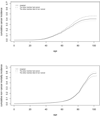Modeling familial association of ages at onset of disease in the presence of competing risk
- PMID: 20002400
- PMCID: PMC2891314
- DOI: 10.1111/j.1541-0420.2009.01372.x
Modeling familial association of ages at onset of disease in the presence of competing risk
Abstract
In genetic family studies, ages at onset of diseases are routinely collected. Often one is interested in assessing the familial association of ages at the onset of a certain disease type. However, when a competing risk is present and is related to the disease of interest, the usual measure of association by treating the competing event as an independent censoring event is biased. We propose a bivariate model that incorporates two types of association: one is between the first event time of paired members, and the other is between the failure types given the first event time. We consider flexible measures for both types of association, and estimate the corresponding association parameters by adopting the two-stage estimation of Shih and Louis (1995, Biometrics 51, 1384-1399) and Nan et al. (2006, Journal of the American Statistical Association 101, 65-77). The proposed method is illustrated using the kinship data from the Washington Ashkenazi Study.
© 2009, The International Biometric Society No claim to original US government works.
Figures





Similar articles
-
A bivariate cure-mixture approach for modeling familial association in diseases.Biometrics. 2001 Sep;57(3):779-86. doi: 10.1111/j.0006-341x.2001.00779.x. Biometrics. 2001. PMID: 11550928
-
Incorporation of the time aspect into the liability-threshold model for case-control-family data.Stat Med. 2017 May 10;36(10):1599-1618. doi: 10.1002/sim.7229. Epub 2017 Jan 23. Stat Med. 2017. PMID: 28114748
-
Analysis of survival data from case-control family studies.Biometrics. 2002 Sep;58(3):502-9. doi: 10.1111/j.0006-341x.2002.00502.x. Biometrics. 2002. PMID: 12229984
-
Folic acid supplementation and malaria susceptibility and severity among people taking antifolate antimalarial drugs in endemic areas.Cochrane Database Syst Rev. 2022 Feb 1;2(2022):CD014217. doi: 10.1002/14651858.CD014217. Cochrane Database Syst Rev. 2022. PMID: 36321557 Free PMC article.
-
[An introduction to competing risks analysis].Rev Esp Cardiol. 2011 Jul;64(7):599-605. doi: 10.1016/j.recesp.2011.03.017. Epub 2011 May 31. Rev Esp Cardiol. 2011. PMID: 21621892 Review. Spanish.
Cited by
-
Measuring early or late dependence for bivariate lifetimes of twins.Lifetime Data Anal. 2015 Apr;21(2):280-99. doi: 10.1007/s10985-014-9309-5. Epub 2014 Sep 4. Lifetime Data Anal. 2015. PMID: 25185657
-
Estimation of time-dependent association for bivariate failure times in the presence of a competing risk.Biometrics. 2014 Mar;70(1):10-20. doi: 10.1111/biom.12110. Epub 2013 Dec 18. Biometrics. 2014. PMID: 24350628 Free PMC article.
-
Methods for generating paired competing risks data.Comput Methods Programs Biomed. 2016 Oct;135:199-207. doi: 10.1016/j.cmpb.2016.07.027. Epub 2016 Jul 25. Comput Methods Programs Biomed. 2016. PMID: 27586491 Free PMC article.
-
Modelling the type and timing of consecutive events: application to predicting preterm birth in repeated pregnancies.J R Stat Soc Ser C Appl Stat. 2015 Nov;64(5):711-730. doi: 10.1111/rssc.12100. Epub 2015 Apr 3. J R Stat Soc Ser C Appl Stat. 2015. PMID: 27239073 Free PMC article.
-
Semicompeting risks in aging research: methods, issues and needs.Lifetime Data Anal. 2014 Oct;20(4):538-62. doi: 10.1007/s10985-014-9295-7. Epub 2014 Apr 12. Lifetime Data Anal. 2014. PMID: 24729136 Free PMC article.
References
-
- Chatterjee N, Hartge P, Wacholder S. Adjustment for competing risk in kin-cohort estimation. Genetic Epidemiology. 2003;25:303–313. - PubMed
-
- Chatterjee N, Kalaylioglu Z, Shih JH, Gail M. Casecontrol and case-only designs with genotype and family history data: Estimating relative risk, residual familial aggregation, and cumulative risk. Biometrics. 2006;62:36–48. - PubMed
-
- Cheng Yu, Fine Jason P, Kosorok Michael R. Nonparametric Association Analysis of Bivariate Competing-Risks Data Journal of the American Statistical Association. 2007;102:1407–1415.
MeSH terms
Grants and funding
LinkOut - more resources
Full Text Sources

